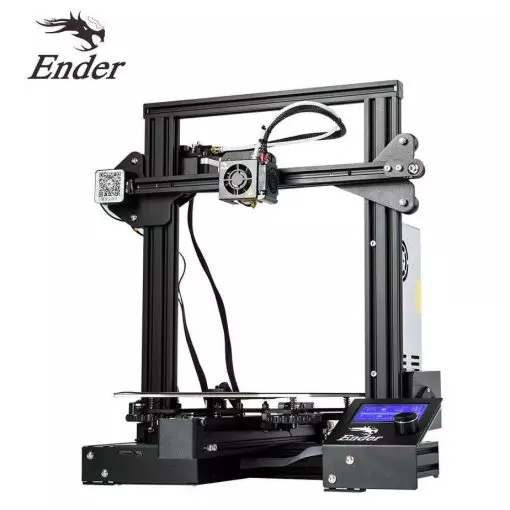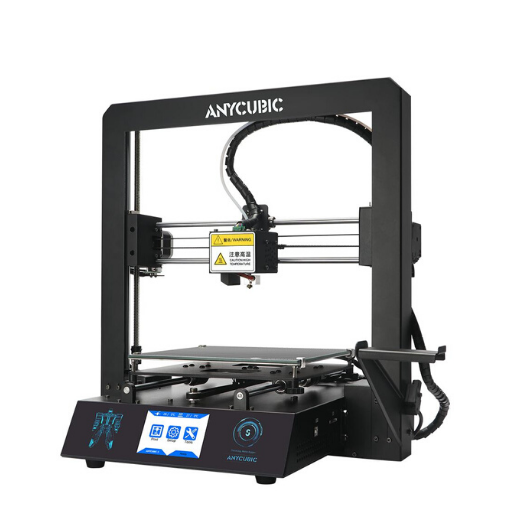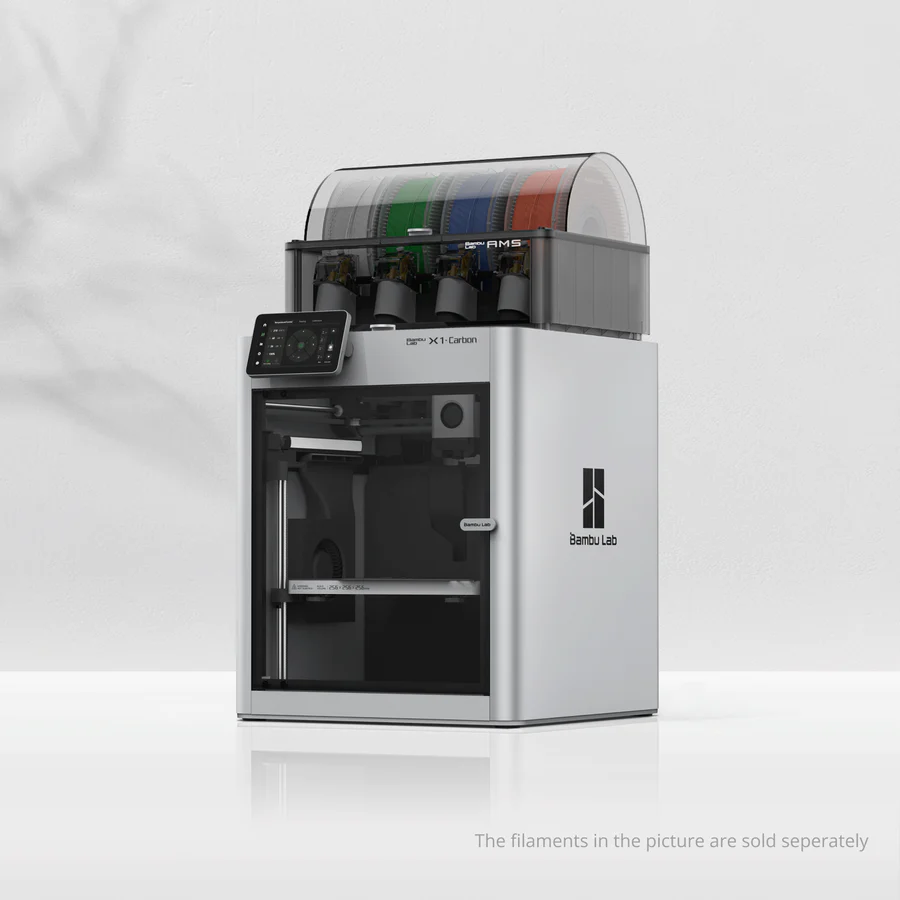Compare Ender 3 vs Mega S vs X1 carbon
Comparison between the best 3D printers
Choose the best 3D printer at the best price. The cheapest 3D printers are here.
Buy a 3D printer here with 3D Fila.
 |
 |
 |
|
| Model | Ender 3[BUY Ender 3] |
Mega S |
X1 carbon |
| Printing Material | Filament | Filament | Filament |
| Estimated price | $210,00 | $149,00 | $1449,00 |
| Fabricante | Creality 3D | Anycubic | Bambu Lab |
| Release Year | 2018 | 2019 | 2023 |
| Print Volume [mm] | 220x220x250 | 210x210x205 | 256x256x256 |
| Printer Size [mm] | 440x440x465 | 405x410x452 | 389x389x457 |
| Weight [kg] | 6,62 | 14,5 | 14,13 |
| Power Loss Recovery | NO | YES | YES |
| Enclosed printer | NO | NO | NO |
| Bed Leveling | Manual | Manual | Automatic |
| Filament End Sensor | NO | YES | YES |
| Bed type | Heated | Heated | Heated |
| Power supply system | Bowden | Bowden | Direct Drive |
| Standard nozzle | 0,4 | 0,4 | 0,4 |
| Maximum Nozzle Temperature [°C] | 255 | 260 | 300 |
| Maximum Bed Temperature [°C] | 110 | 110 | 120 |
| Maximum printing speed [mm/s] | 180 | 100 | 500 |
| Filament holder | YES | YES | YES |
| Camera for supervision | NO | NO | YES |
| Recommended filaments | PLA, TPU, ABS, PETG | PLA, TPU, ABS, PETG | PLA, PETG, TPU, PVA, PA, PA-CF, Nylon, PC |
| Recommended slicers | Cura, Simplify, Slic3r | Cura, Simplify, Slic3r | Bambu Studio, Super Slicer, Cura, Prusa Slicer, Orca |
| Maximum Resolution [mm] | 0,1 | 0,1 | 0,1 |
| Processor | 8 bits | 8 bits | Quad ARM A7 1.2 GHz |
| Display | Mono | Touchscreen TFT 2,8'' | Touchscreen 5'' |
| Power Supply | 24V / 270W | 12V / 300W | 350 W |
| Connectivity | SD / USB | SD / USB | Wifi, Bambu bus, Cartão SD |
| Operating systems | Windows, Mac, Linux | Windows, Mac, Linux | Windows, Linux, Macbook |
| Date of registration in the system | 2021-04-13 | 2021-04-15 | 2024-04-10 |
| Release date | 2018 | 2019 | 2023 |
| Extra features | The Ender 3 V1 is a DIY assembly 3D printer, a sales leader since 2017, standing out for its cost-benefit. With a wide printing capacity, it has a CNC machined structure for precision and stability. It offers high-precision prints with low noise, thanks to its innovative V-profile and pulleys. It has a self-adhesive magnetic platform for easy removal of models and excellent adhesion. The Ender 3 heats up quickly, reaching 100°C in 5 minutes, ideal for agile prints. It includes protection against power failures, allowing you to resume printing after interruptions, saving time and material. | The Anycubic Mega S offers a printing platform with excellent adhesion, easy removal after cooling. It has a filament sensor for a better experience with flexible materials and a multilingual and intuitive color touchscreen. Assembly is quick, requiring only 8 screws and 3 connections. It has a large build volume (210 x 210 x 205 mm), high positioning accuracy and supports a variety of materials, including TPU, PLA, ABS and wood. It stands out for its solid metal structure, superior stability, high-quality printing with layer resolution of up to 50 microns, Ultrabase for easy adhesion and removal of parts, resumption of printing after power outage, high-quality extruder for flexible filaments, suspended filament support and stable structure that reduces shaking, improving printing quality. | The Bambu Lab X1 Carbon revolutionizes 3D printing with stunning design, high print speeds, and a streamlined user experience. It stands out with its CoreXY system, a hotend capable of reaching 300°C, allowing for a wide range of filaments. Its LiDAR-assisted bed leveling system, vibration compensation, and AMS multicolor printing capability raise the industry standard. Print quality is impressive, with the ability to fine-tune for perfection. The X1 Carbon, with its closed build volume, not only promises but also delivers one of the most advanced 3D printing experiences available to consumers. |
| Support for multiple colors and materials (AMS and CFS) | NO | NO | YES |
Notes * |
|||
| Cost-benefit | 6 / 10 | 7 / 10 | 7 / 10 |
| Hardware | 0.5 / 10 | 2 / 10 | 6.4 / 10 |
| Screen | . | . | . |
| Print volume | 3 / 10 | 3 / 10 | 4 / 10 |
| Performance | 1 / 10 | 1 / 10 | 4 / 10 |
| [BUY Ender 3] |
Conclusion |
| In comparing the Ender 3, Mega S, and X1 Carbon 3D printers, it is evident that each model caters to different user needs and budgets while offering unique features that set them apart. The **Ender 3**, known for its affordability and solid performance, is an excellent choice for hobbyists and beginners. It offers a decent build volume and straightforward assembly, making it a popular entry-level option. However, it lacks advanced features such as power loss recovery and automatic bed leveling, which are found in more sophisticated models. Its cost-performance ratio is reasonable, especially for users looking for a reliable 3D printer without breaking the bank. The **Mega S** presents itself as another budget-friendly option, slightly cheaper than the Ender 3. It provides a user-friendly experience with a touchscreen interface and a filament sensor, enhancing print reliability. Despite its lower price, it also includes power recovery features similar to the Ender 3. However, it still has limitations in print speed and build volume compared to more advanced models. On the other hand, the **X1 Carbon** is a powerhouse with a significantly higher price point but justifies its cost through advanced features such as automatic bed leveling, high maximum print speeds, and the ability to handle a wider range of materials. It provides a user experience that incorporates cutting-edge technology like LiDAR-assisted leveling and multi-color printing capabilities. This model is designed for users who demand high performance and versatility, particularly in professional or specialized environments. In conclusion, for budget-conscious users or novices, the **Ender 3** and **Mega S** represent solid value with their affordable pricing and satisfactory capabilities. In contrast, the **X1 Carbon** is aimed at more serious enthusiasts or professionals who require advanced functionalities and are willing to invest more for a premium experience. Ultimately, the choice should depend on the user's budget, experience level, and specific printing needs. |

